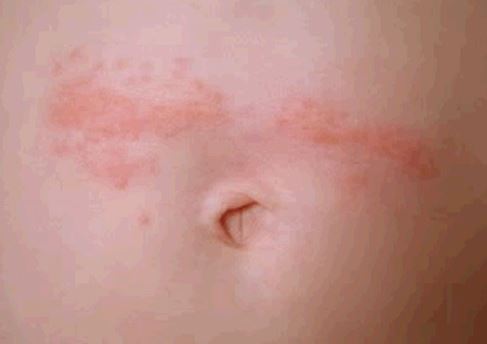The belly button is made up of scar tissue from when the umbilical cord joined the growing fetus to the mother’s placenta. The umbilical cord is the route all nutrients and oxygen travel from the mother to the fetus and the route all the wastes products leave the fetus. All placental mammals have belly buttons, but in humans it is very prominent. There can be many reasons that a rash develops around the belly button, ranging from infections, allergies to other medical conditions.

Why Do I Have Rash Around Belly Button?
The causes of having a rash around the belly button are numerous. Below are a few possible causes:
1. Infections
Different strains of bacteria and fungi can cause infections around the belly button. This can cause inflammation, pain and even discharge from the infection. Certain bacterial infections can also cause nausea and vomiting in the person. The bacteria commonly involved are Staphylococcus aureus and Streptococcus pyogenes. The fungus most commonly causing the rash is Candida.
- For bacterial infections, antibiotic topical medicines can be prescribed.
- Fungal infections are treated with anti-fungal creams.
2. Poor Hygiene
The belly button is often neglected in your personal hygiene regime. Usually the belly button is left moist, which can lead to infections when combined with a build-up of dirt. The navel is the perfect breeding ground for bacteria and fungi. Dirt may take the form of lint from clothes and body hair that have become embedded into the navel. If you pierce your navel but don't care for the wound, it's likely that infection would set in, leading to redness and pain. An infected navel piercing may bleed initially then release pus.
3. Allergic Reactions
Some people are very sensitive to certain allergens like nickel, new laundry detergent or skin cream. Exposure to these triggers may cause an allergic rash around belly button.
- The best way to prevent this type of rash is to recognize and avoid the trigger. Initially, you may have to consult a doctor to get the rash under control.
4. Psoriasis
This autoimmune skin disease develops patches of skin that are red, inflamed and itchy. This condition can range from mild to severe.
- The treatments of psoriasis around the belly button depend upon the severity of the condition.There are creams available for mild cases. More severe rashes of this sort may require treatments like topical anti-inflammatories and vitamin D.
5. Pregnancy
Itching around the navel area during pregnancy is very common and is due to the rapid stretching of the skin on the abdomen. Expanding skin is usually dry, which contributes to the itchiness and discomfort. You can use moisturizing products to moisturize the skin on the expanding skin. Avoid scratching the skin because you may cause breaks in the skin with very vigorous scratching, thus leading to a bacterial infection. Itching around the belly button stops once the pregnancy is over.
- Pregnant women are encouraged to massage in sufficient moisture to their expanding skin. There are numerous products available commercially to moisturize your skin.
6. Menstruation
Some women experience pemphigoid gestationis which is a blistering disease around the belly button. It is thought to be due to high levels of the hormone estrogen during menstruation but this condition is very rare.
How to Relieve Rash Around Belly Button with Home Remedies
- Salt water: A mild infection of the belly button can be cured by a warm solution of salt. One teaspoon of salt dissolved into 1 cup of warm water will act as the perfect disinfectant. Use a cotton ball to dip in the solution and gently cleanse the area. Ensure you dry the area afterwards. Repeat this procedure twice daily until the infection is completely cleared.
- Antibacterial soap: While bathing, use an antibacterial soap to cleanse the area. After bathing, ensure that the belly button is as dry as possible and apply some antibacterial cream to the area.
- Tea tree oil: This essential oil has anti-fungal, antibacterial and antiseptic properties. Mix about 5 drops of tea tree oil into 1 teaspoon of coconut or olive oil. Use a clean cotton ball to apply to the rash around the belly button. Leave for about 5 minutes then wipe away gently with a clean tissue. Repeat a few times daily until the rash has healed.
- Rubbing alcohol: Alcohol can act as an antiseptic and prevent a spread of the infection. Use a clean cotton ball to apply to the affected area. Repeat this a few times daily to promote healing.
3. Experiences Sharing on Rash Around Belly Button
"I have had a rash around the belly button for about one month. I was advised to take cool baths and wear loose cotton clothing. I have also applied calamine lotion to soothe the itching. I have changed my laundry detergent and use very mild body lotions with no additives. I am keen to see if the rash abates with all these changes I have made."
"I have a redness around my belly button that has not responded to the rubbing alcohol. I consulted my doctor who diagnosed a fungal infection. I now am applying anti-fungal cream. The rash seems to be clearing up."
